The mine: Geology and stability problems
The Asse mine being a salt mine, it was not intended right from the start to use it as a repository for radioactive waste. The original goal was to exploit the salt deposit in the Asse as effectively as possible. In doing so, chambers were mined that reach up to the outermost edge of the salt layer. The reason for this being a problem for the stability of the mine can be recognised by having a look at the Asse's geology.
Geology: Rock structure
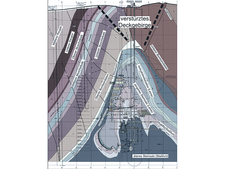
![]() The sectional drawing of the mountain shows how close the mining chambers come up to the overlying rock.
Source: Helmholtz Zentrum München
The sectional drawing of the mountain shows how close the mining chambers come up to the overlying rock.
Source: Helmholtz Zentrum München
The Asse-Heeseberg mountain range consists of different Zechstein sequences, Zechstein being an approximately 230 million-year-old salt rock. One feature of salt rocks is that they intrude into weak zones of the overburden (such as fault zones) when they overlap with overlying strata. In the case of the Asse they were upfolded to a saddle below the younger overlying rock, therefore they are referred to as a saddle structure. The core of this saddle consists of the older Staßfurt rock salt (dark blue). Above this is the Staßfurt potash seam (carnallitite), which is likewise a salt rock (pink). Further strata above are the younger Leine rock salt (mauve) as well as Anhydritmittelsalze (light blue), a mixture of rock salt and the mineral anhydrite.
Overlying and adjoining rock surrounding the salt structure mainly consist of different Bunter layers (mudstone, sandstone, and limestone) as well as of Muschelkalk and Keuper that developed later in the earth's history. Directly above the centre of the saddle, the rock layers are interrupted and displaced against each other: The overlying rock is disrupted here. Besides, there are numerous faults in the south-western flank of the saddle (left part of the figure) which can be envisaged as cracks in the rock. In the figure they have been presented as narrow broken lines.
The mine: Inflow of saline solutions and stability problems
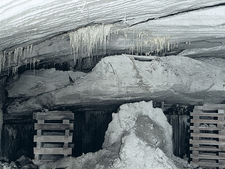
![]() Loose rocks and drip points in mining chamber 5 on the 700-m level (1993)
Loose rocks and drip points in mining chamber 5 on the 700-m level (1993)
During the period of salt production, numerous chambers were driven in the Asse II mine situated closely on top of each other in the south-western flank of the mine. In order to waste as little of the resource as possible, the salt was mined with short distances between the mining chambers and partially immediately up to the adjoining rock.
At some places, the chambers in the salt layers reach up to five metres to the adjoining rock. The distances between the mining chambers are twelve metres and the intermediate roofs (pillars) are partially only six metres thick.
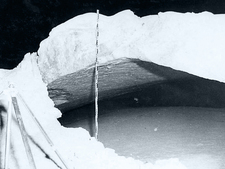
![]() Bulging of the floor in mining chamber 6 on the 553-m level (1967)
Bulging of the floor in mining chamber 6 on the 553-m level (1967)
Today, the very large total volume of open drifts and chambers and the closeness of the chambers to the adjoining rock cause the major problem in the Asse mine. The natural movement of the rock presses the chambers together, thus breaking up the salt rock and the adjoining rock. Clefts have developed through which groundwater can flow, which is saturated with salt in the area of the salt structure. Since 1988, these waters flow into the mine in the upper part of the southern flank, in depths between about 500 and 575 metres.
Moreover, the chambers themselves are becoming instable through the rock movement. Part of the intermediate roofs (pillars) between the chambers has already collapsed. Therefore, rock movements can create new clefts (cracks) at any time through which more water could flow into the mine. In an extreme case the inflow of groundwater from the overlying rock could increase so much that the mine could drown before the closing measures have been completed and, thus, groundwater could come into contact with radioactive waste.
Stabilisation measures
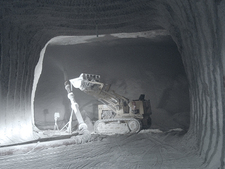
![]() Backfilling of old mining chambers with salt grit by pneumatic stowing between 1995 and 2004 (2003)
Backfilling of old mining chambers with salt grit by pneumatic stowing between 1995 and 2004 (2003)
To slow down the shifting of the rock and to prevent more intermediate roofs from collapsing, the former operator of the Asse mine, Helmholtz Zentrum München, backfilled the chambers in the southern flank of the mine with salt grit. Approximately 2.2 million tons of salt grit were blown into the cavities with compressed air between 1995 and 2004.
As the material contains a higher proportion of air - the pore volume being approximately 40 percent – it has slumped in the course of time due to its own weight. On account of this, cavities have formed at the roof of the chambers, so-called roof clefts.
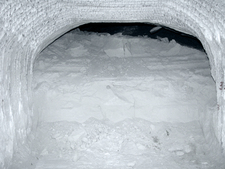
![]() Roof cleft in the access area of a former mining chamber (2009)
Roof cleft in the access area of a former mining chamber (2009)
The salt grit can only have its full supporting effect after it has been pressed together so much that the voids (pore space) in the stowage and the roof cleft have been completely closed.
When that has happened, one can hardly tell apart the backfilled mining chambers from the surrounding salt dome and they will show a similar stability. However, many decades will pass until this will have happened.
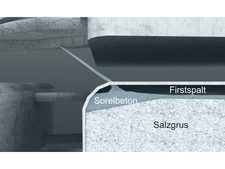
![]() Schematic diagram of roof-cleft backfilling
Schematic diagram of roof-cleft backfilling
In order to improve and accelerate the stabilising effect, the Federal Office for Radiation Protection started to backfill the roof clefts in the mining chambers situated in the southern flank with a special type of concrete. This has contributed to reducing the cavity volume and achieving a bearing capacity in less time.
Also the movements of the rock decrease as a result of the stabilisation measures. The risk of an uncontrolled inflow of groundwater does no further increase. This is absolutely essential for the further operation of the repository until it will have been decommissioned.

